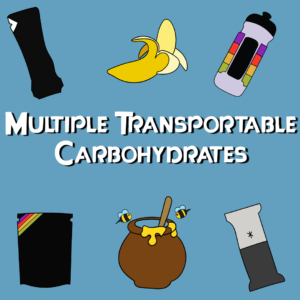TLDR: Combining glucose and fructose, known as multiple transportable carbohydrates enhances carbohydrate absorption and oxidation during endurance events. This strategy allows athletes to consume 60–120g of carbs per hour, improving performance while reducing gastrointestinal discomfort. Incorporate this approach into training to adapt your gut and optimise race-day fuelling.
Fuelling effectively during endurance events can be the difference between a personal best and crashing and burning before the finish line. A lot of athletes know that they should be consuming carbohydrate during their runs and this can absolutely be a game changer, but the type and combination of carbohydrates you consume can also give you an additional edge over your competition. Multiple transportable carbohydrates have become a cornerstone of sports nutrition and have transformed how athletes approach fuelling during long races and intense training sessions. In this article, we’ll explore what multiple transportable carbohydrates are, their benefits for endurance athletes, and how you can integrate them into your training for optimal performance.

Multiple transportable carbohydrates refer to a combination of different types of carbohydrates, most commonly glucose and fructose, that are absorbed through specific transporters in the digestive system, hence the name.
This strategic combination allows for a greater rate of carbohydrate absorption and oxidation than using glucose alone [1-3]. We have some pretty good research indicating that 60g/hour for most people is the most glucose we can comfortably digest and absorb without issues [3, 4]. The reason for this is you have specific transporters in your gut that take up glucose and once you are hitting 60g/hour these transporters become saturated, they simply can’t take up any more than this. The good news is you also have specific transporters that take up the other sugar we are discussing, fructose, which is commonly found in fruit and honey. So when you are hammering your digestive system with only glucose, those transporters are working overtime whilst your fructose transporters are sat with their hands in their pockets waiting for something to do. By utilising both pathways simultaneously, athletes can push their carbohydrate absorption rates beyond the limits of a single source, leading to enhanced carbohydrate availability and reduced risk for digestive issues during prolonged exercise[5]
Having multiple transportable carbohydrates as a part of your fuelling strategy offers several key benefits that make them particularly effective for endurance athletes:
To really get the benefits from multiple transportable carbohydrates, it’s essential to incorporate them both into your training and racing routines. Here’s how:
Different gels, bars and drinks will use different ratios with the 2:1 or 1:0.8 ratios being the most common and evidence based. The important takeaway is that both combinations have been shown to enhance carbohydrate absorption and oxidation.
Some recent research has suggested the ratio of 1:0.8 provides additional benefits versus the 2:1 ratio from both a gastrointestinal comfort and performance standpoint[1, 2], which is most likely due to more efficient intestinal absorption of both monosaccharides. For this reason I typically nudge my athletes towards this ratio.
No. You can use regular food instead of gels and bars for fuelling during endurance events. Foods like fruit and honey contain both glucose and fructose. This might be your preference from a taste and/or texture perspective and could be more cost effective too. You should consider a few things before doing this though.
During high-intensity exercise, the digestive system can struggle to break down and absorb more complex foods, especially foods higher in fibre and fat. Gels and bars are formulated to be easily digestible, reducing the risk of gastrointestinal discomfort. Gels and bars are designed and packaged for ease of use during exercise. They are lightweight, easy to carry, and quick to consume, which is just really handy. Sports products are designed to provide exactly what you need in terms of carbohydrate, electrolytes, and sometimes caffeine. Whilst not impossible, this can be difficult to replicate with whole foods. Use gels, bars and drinks takes a lot of the guesswork out of your fuelling strategy.
The science in this area will continue to evolve, with ongoing research exploring even more efficient carbohydrate combinations and innovative ways to deliver these nutrients during exercise. Additionally, emerging technologies such as continuous glucose monitors are beginning to provide real-time on blood glucose levels. I’m not sold on this tech as a commercial product for athletes, for a variety of reasons, but I could see it being useful from a research perspective.
Multiple transportable carbohydrates are a fairly simple but powerful tool for endurance athletes, offering increased carbohydrate oxidation, enhanced performance, and improved hydration with reduced gastrointestinal distress, what more would you want! By incorporating these carbohydrates into your training and upcoming races, you could be well on the way to your next PB.

Paul is a sports nutrition consultant and educator with a PhD in Nutrition and Exercise Science. With over a decade of experience, Paul specialises in optimising performance and recovery for endurance athletes through evidence-based strategies. As a lecturer and researcher, Paul has published in peer-reviewed journals and worked with athletes, sports teams, and organisations to achieve peak performance.
